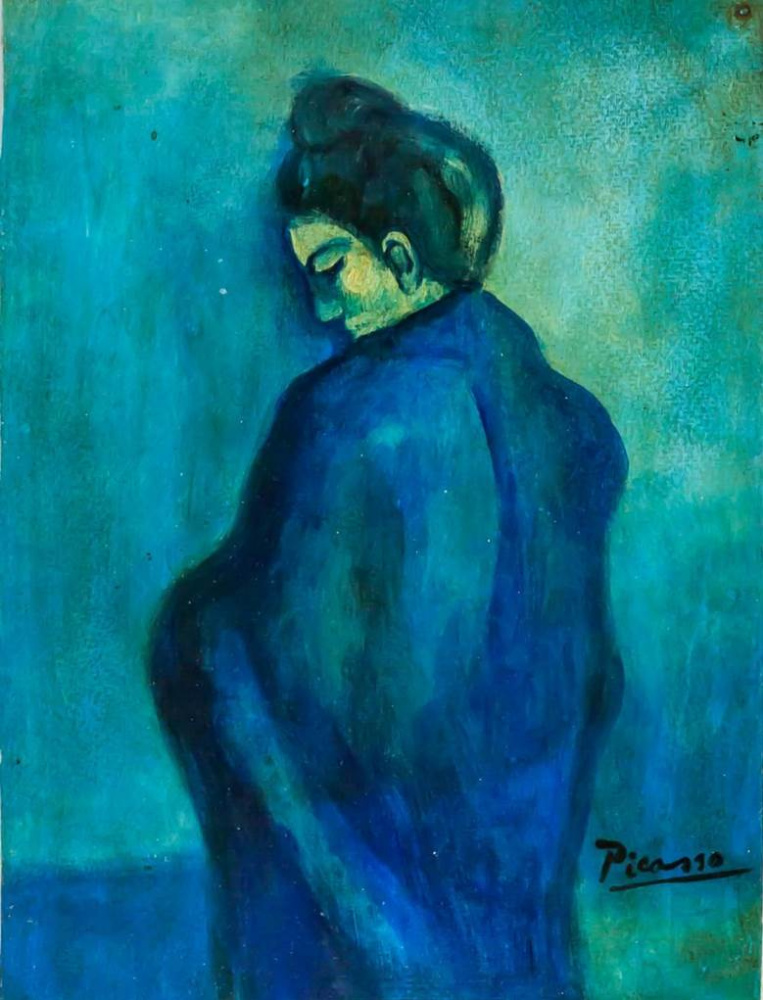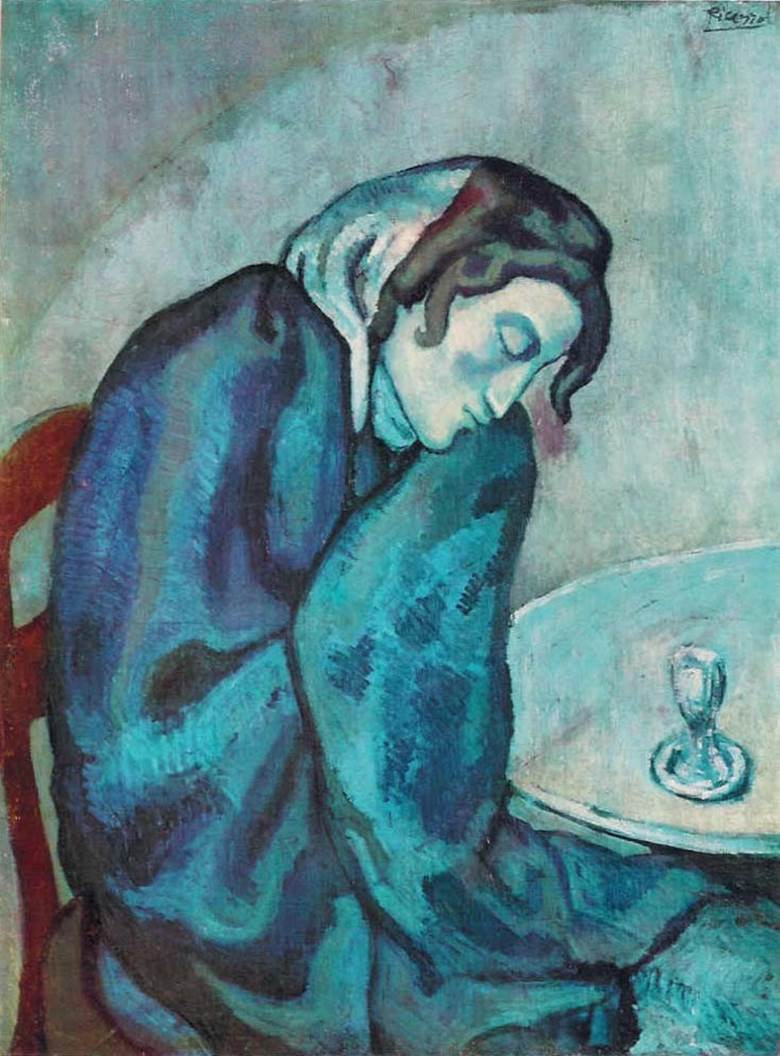In this article on Arthive, you will learn about the works and paintings of the Spanish artist Pablo Picasso during the "blue period" between 1901 and 1904, when he painted monochrome paintings in shades of blue and blue-green, only occasionally warmed by other colors.

Known to be one of the more famous artists, Pablo Picasso’s influence in the world of art has been quite notable. However, one of the most important times of this artist’s presence in this sector was the Blue Period. If you are an art enthusiast and want to know more about Picasso’s blue period, this article is the right place to be.
Description of the Blue Period
The blue period Picasso is a name given to the artworks of Pablo Picasso during the years 1901 and 1904. During this time period, he made art that was primarily monochromatic. Most of the blue period artworks had shades of blue-green, blue, and occasional warm tone highlights.Picasso’s blue period artworks were mostly dark and gloomy and mainly influenced by Spain during this time. These artworks were painted in Paris and Barcelona and were some of his best works to this day. However, even though these artworks are celebrated today, he had quite a hard time selling them in those years.
While the exact point of start of this period is quite hard to pin-point, it is speculated that this might have started during the springtime of 1901 in Spain or the latter half of the year in Paris.
As mentioned above, all the Pablo Picasso blue paintings of this time depict his journey through Spain. Nevertheless, there was a deeper insight into the morose tone of the paintings, which was later discovered.
During Pablo Picasso’s blue period, he started making sadder paintings, which his consumers did not really appreciate. The main reason this time period of Picasso’s work received this name was that he mainly shifted to a blue color palette. Along with that, since blue is a color that is often associated with sadness, this was the blue period meaning art enthusiasts got.
Pablo Picasso has shared a very distinct quality in his treatment of space, colors, mood, and even subject matter in his paintings throughout his life.
However, after the demise of his good friend, Picasso’s blue painting followed a rather unorthodox approach to his style. He started using the poor and needy as his subjects and did not cater to what his audiences really liked him for or even wanted.
He was usually the kind of artist who used to paint a number of canvases, sticking to one style or artistic idea. For the Pablo Picasso blue period, his inspiration was the death of his close friend and also his lover being in jail.

Blue period meaning
While there was a lot of Picasso painting the blue period, which has gained immense popularity in the recent ties, there are not many that were as famous as La Vie. This painting was painted in the year 1903, which was when Picasso was at the height of his depression. This painting is still showcased as a permanent collection of the Cleveland Museum of Art.
Painted in Barcelona, this portrays two pairs of people and a naked couple confronting a mother who has a child in her arm. There appears to be a studio in the background of the room in the painting, and there are two paintings within this painting. Such surrealism of the painting is why it was regarded as the pinnacle of Pablo’s Blue Period.
This painting has also been compared to Vincent Van Gogh’s Sorrow, another famous painting of earlier times. The interpretation of this art piece has always been a subject of discussion between art enthusiasts.
The male figure is clearly a portrait of the friend he lost during this time. However, the fact that there is a confrontation between two groups makes it probable that the painter might have addressed self-reflecting questions.
However, the crucial point of this painting has to be the enigmatic gesture in the middle of the composition. This has been agreed upon by art enthusiasts as well as critics and scholars.
Painted in Barcelona, this portrays two pairs of people and a naked couple confronting a mother who has a child in her arm. There appears to be a studio in the background of the room in the painting, and there are two paintings within this painting. Such surrealism of the painting is why it was regarded as the pinnacle of Pablo’s Blue Period.
This painting has also been compared to Vincent Van Gogh’s Sorrow, another famous painting of earlier times. The interpretation of this art piece has always been a subject of discussion between art enthusiasts.
The male figure is clearly a portrait of the friend he lost during this time. However, the fact that there is a confrontation between two groups makes it probable that the painter might have addressed self-reflecting questions.
However, the crucial point of this painting has to be the enigmatic gesture in the middle of the composition. This has been agreed upon by art enthusiasts as well as critics and scholars.
Interesting Facts of the Blue Period
As is mentioned in several studies of his paintings, the Blue period paintings were a way for him to deal with the sadness and impact his friend, Carles Casagemas’s suicide had on him.Carles was a very dear friend to Picasso and took his like ion the L’Hippodrome Café, which was located in Paris. He took his life through with a point-blank shot to his temple in 1901. However, there is a lot of controversy regarding this.
There is an excerpt where Picasso himself agreed to the fact that he started his Blue period art because of his friend’s suicide. However, art historians often argue that this was just a form of psychologizing justification.
The main point of confusion is the chronology of the events. Firstly, Picasso was not present in Paris when the incident happened. More so, he only got to know about his friend after he came back to Paris in May, which was the second half of the year.

Blue picasso paintings
That being said, once back, he stayed in the studio of his departed friend and worked for several weeks on the art he later displayed at Ambroise Vollard’s gallery. However, the reviews of these Picasso blue period paintings were quite pleasant, if not overwhelming. It was said to be a dazzling palette with high-spirited subjects. Nevertheless, as 1901 continued, Picasso’s mental state deteriorated even further.
The second half of the year did not show too much promise for Picasso as he sank into chronic depression. Following his friend’s suicide, Picasso finished his masterpiece La mort de Casamegas, which was named after him. However, this painting did not really follow the color palette of Picasso’s blue period art and consisted of mostly warm tones and bright colors.
With this painting, the Picasso blue period prints began, and the rest is history. Casemegas in his coffin was another artwork named after his lost friend, which was finished later that year. This painting was a clear representation of Picasso’s crippling depression. Usually an outgoing socializer, Picasso withdrew from his friends and stopped leaving his studio very often.
The second half of the year did not show too much promise for Picasso as he sank into chronic depression. Following his friend’s suicide, Picasso finished his masterpiece La mort de Casamegas, which was named after him. However, this painting did not really follow the color palette of Picasso’s blue period art and consisted of mostly warm tones and bright colors.
With this painting, the Picasso blue period prints began, and the rest is history. Casemegas in his coffin was another artwork named after his lost friend, which was finished later that year. This painting was a clear representation of Picasso’s crippling depression. Usually an outgoing socializer, Picasso withdrew from his friends and stopped leaving his studio very often.

the blue period picasso
While everyone knows Picasso was suffering from chronic depression in his last years of life, this is when it started. Before the year 1901, his career was flourishing, and he was making a considerable amount of money in Paris. However, ever since the Picasso blue period, his career decline drastically.
This was mainly because he started making society’s outcasts and poor the subjects for his paintings. In addition to that, he changed the color language for Pablo Picasso’s blue period paintings as well. For starters, he used a gloomy and cool color tone with more blue.
This sat well with neither the public nor the critics, and they became uninterested in his work. That said, Picasso did not stop making his artwork, but his financial condition suffered a considerable blow.
This was mainly because he started making society’s outcasts and poor the subjects for his paintings. In addition to that, he changed the color language for Pablo Picasso’s blue period paintings as well. For starters, he used a gloomy and cool color tone with more blue.
This sat well with neither the public nor the critics, and they became uninterested in his work. That said, Picasso did not stop making his artwork, but his financial condition suffered a considerable blow.
Paintings by Pablo Picasso of the Blue Period
Irrespective of how the critics and consumers reacted to his art, Picasso made some of the most influential the art during the Picasso blue phase. Some of his most notable Blue Picasso paintings include:
picasso’s blue period artworks
• Le Gourmet (The Greedy Child), 1901
• Les deux saltimbanques (Harlequin and his Companion), 1901
• Woman with Folded Arms (Femme aux Bras Croisés), 1901−1902
• La soupe (The soup), 1902−1903
• Desemparats (Mère et enfant au fichu, Maternité, Motherhood), 1903
• La Vie, 1903
• The tragedy, 1903
• Portrait of Suzanne Bloch, 1904
• Les deux saltimbanques (Harlequin and his Companion), 1901
• Woman with Folded Arms (Femme aux Bras Croisés), 1901−1902
• La soupe (The soup), 1902−1903
• Desemparats (Mère et enfant au fichu, Maternité, Motherhood), 1903
• La Vie, 1903
• The tragedy, 1903
• Portrait of Suzanne Bloch, 1904














